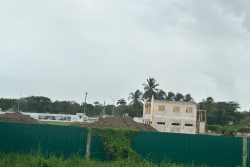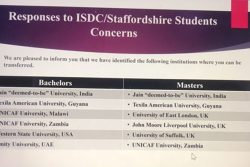Guyana Power and Light Inc (GPL) Chief Executive Officer Bharat Dindyal yesterday announced that the company is expected to receive US$60M from the Inter-American Develop-ment Bank (IDB) and the European Union (EU) for infrastructural improvement which will address the long-running problem of technical losses.
The announcement comes weeks after GPL was rapped by the Public Utilities Commission (PUC) regarding its $7B in system losses for 2013.
In a public presentation led by GPL’s key Directors at Duke Lodge yesterday, Dindyal announced that with the approval of the US$60M, the company will tackle the huge problem of system losses from a technological standpoint. The funds have been approved for network and infrastructural support to reduce system losses in Guyana’s Power Supply System. Dindyal called the loan the largest of its kind and spoke optimistically of the expected impact, saying that the bank has given the utility five years to roll out the change but he hopes to get it done much sooner so that Guyana can start seeing the benefits.
Critics have argued that GPL and its predecessor the Guyana Electricity Corporation have soaked up large loans from the IDB and other donors for generation and transmission and distribution projects but that major problems – particularly line and commercial losses – continue to beset the oft-criticised utility.
Dindyal in detailing the focus of the funding said that GPL will direct the investment over the next three years intensely in Region Four, since the region accounts for 72% of the country’s overall losses. He said the approach will be divided into two fronts: a technical and a non-technical one, to be administered through a system of turnkey projects offered to contractors. This, he said, would be geared towards reducing losses by 5% on the technical front and 3% on the non-technical front. Dindyal said that the network is being designed to be fraud proof and up to international standards. He stated that theft accounts for a significant portion of their losses, at an estimated $2.4B per year.
In order to make the system fraud proof, Dindyal said that the Advanced Metering Infrastructure (smart meters) is the key. The smart meters had been deployed on a pilot programme, with installation in the Georgetown business hub several months ago. The AMI programme incorporates technology that allows electricity meters to be read remotely and is also financed under the loan agreement with the IDB. The meters are capable of remotely disconnecting and reconnecting consumers, can monitor electricity consumption in real time while providing voltage regulation reports, but most importantly, the power company is able to specifically identify where leakages in electricity have occurred or are occurring.
The initial results of the pilot programme are in, Dindyal said with great enthusiasm. “The AMI is providing astonishing data which will soon be released to the public. We are receiving valuable information on theft and power quality which will be shared with the design and control centre. The meter vendors are here to validate the findings and to initiate a second audit,” Dindyal said. The CEO pointed out that GPL has been able to gather such concrete information about electricity theft by businesses that there’s just no denying it. This information he hopes will be used to secure convictions that would serve as a deterrent to all others who are stealing or contemplating the act.
Earlier this month, the PUC said actual losses at the end of last year were reported by GPL at approximately 31%, with a reduction of .8%, which was below the company’s in-house reduction target of 1.6%. It noted that the standard set system losses at 28.1% of dispatched power for 2013, down from 28.65% in the previous year.
The PUC said system losses cost the company over $7 billion in 2013 and the cost looked set to continue into 2014 and beyond. “The losses are collectively borne by the company and the Government. Rather than financing the losses as is the common practice it makes sense to identify components of the system losses and make the investment in reducing either singularly or in total each of the loss components. At some point this would have to be done and the sooner a start is made the better,” the PUC recommended.
The PUC warned that consistent failures in not meeting the system losses standard will widen the gap between the standard and the actual losses in the ensuing years.
In other developments, five out of eight new feeders are expected to go online in June. This, Dindyal said, will provide much needed relief from the central Georgetown circuit. Several new substations are expected to be built in places like Vreed-en-Hoop, Good Hope, Anna Regina, Bartica, Leguan, Wakenaam and Onverwagt, the one expected to be completed in one and a half weeks. These new substations, Dindyal said, would provide perfect voltage and create a transmission link between Demarara and Berbice. No longer will a small trip bring down the entire Berbice system, he added.








